Neo: The World Ends With You (PS4) Review
In a rare look at a recently released video game, it’s time to answer this question: how can you follow up a 2007 Nintendo DS game on home consoles in 2021? Given the core input method at the very least would have to change, it would be a hard ask. Let’s see if Square Enix and the team at h.a.n.d. were up to the challenge!
Background:
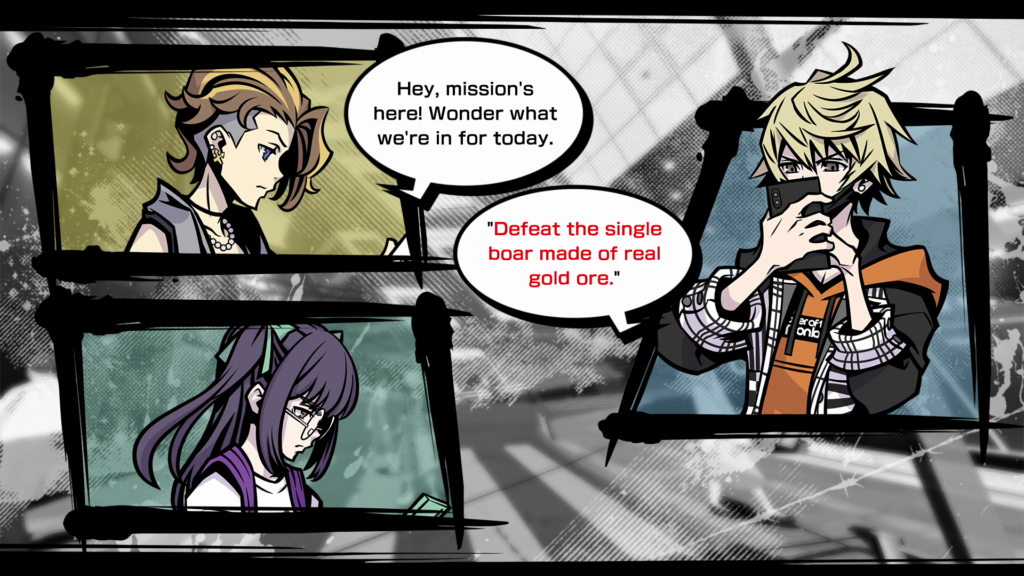
NEO: The World Ends with You is a sequel to the Nintendo DS game simply titled The World Ends with You, released in 2007. While the game was popular, it wasn’t popular enough to immediately get a sequel greenlit; instead it was mentioned by producer Tetsuya Nomura on a few occasions as something he wanted to do, but a lot of the original team ended up on Kingdom Hearts projects instead. A HD port of the game appeared on mobile devices in 2012 (subtitled “Solo Remix”) and a Switch port appeared in 2018 (subtitled “Final Remix”) that included a new post-game story, making people wonder if this was a sign that a sequel was finally in the works. Sure enough, the game was soon announced, along with an anime adaptation of the original game, both coming out in 2021 with NEO arriving on both the Nintendo Switch and PS4 in July.
Gameplay:
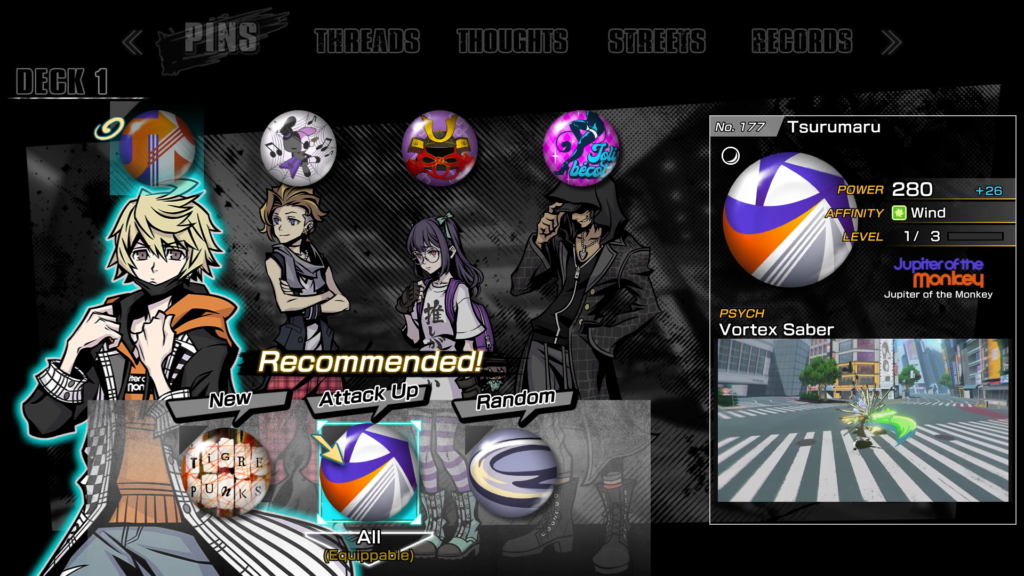
The gameplay is where the major change in Neo comes from, given the original TWEWY game was on the dual-screened DS and controlled entirely by the touchscreen. First you control three to four characters at a time as the Reaper Game, this time is fought between teams (more on the story later!) but some things remain familiar, like fighting “Noise”, the enemies of the game, by choosing special icons that float in the world, with the more icons you pick, the more enemies you fight and the harder they become but the drops are better and multiplied. Also returning is the use of “Pins” as your main source of offense. You collect Pins (as in pin badges, not just regular pins… Not that pin badges having magical properties makes more sense, but you know… just for the record.) Each one will give you access to a specific Psyche move, which can vary from long range or close combat, timed bombs to healing, plus with various elemental effects that enemies can be naturally weaker too. Each member of your party can have one Pin and each one has a button associated with it, therefore it you have two Pins you want to use but both have Triangle as the input you’ll be out of luck.
The Pins level up as you use them though only a set amount, leading to the simple but effective gameplay loop of unlocking naturally more powerful Pins and swapping them to level them up, giving the combat a fresh feeling every few in-game days (or fewer if you’re like me and couldn’t help levelling up nearly every Pin you came across…) With over 300 Pins it can be a satisfying time-sink if you’re not careful! The other part of combat modified from the original game is increasing your “Sync” meter, which here is done by following up a partner’s attack with another within a few seconds, chaining different moves together via good teamwork (essentially it’s just you doing timed combos with different buttons…) If your Sync reaches 100% you’re able to do a Fusion attack for significant damage. Throw in the fact that all of your team share the same health bar and ability to sidestep and dodge enemy attacks and that’s the actual combat part done, but we’re not done with ways you can alter your in-game stats!
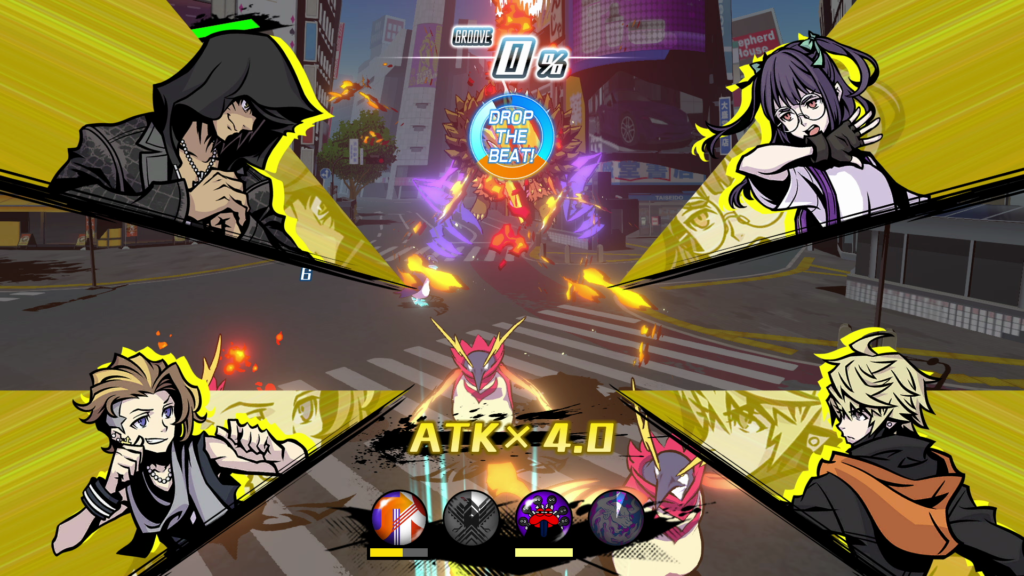
During the non-combat side of the game, where you can walk about the city and the storyline unfolds, you can visit shops and restaurants. The shops mostly offer clothes you can purchase and equip your characters with that can grant them both a boost to HP, damage, defence and the like, but also if the character in question has enough style to pull off the outfit, they can get further buffs and bonuses. Some shops offer unique Pins or music discs of the game’s OST if you wish to listen to them in isolation, plus one offers books that give you gameplay tips, which is an odd thing to have to buy but there you go. It won’t shock you to find out that the restaurants offer food, each food item can give you temporary buffs to your party’s stats, with each party member having certain food types they like and the more they like it,, the higher the buff. Oddly, food is one of the only places you can increase your party members’ style so you can unlock the clothing buffs, I guess it’s purely for gameplay loop purposes rather than trying to make sense, unless eating food you like makes you more stylish in the eyes of others and I’ve just never noticed? … Anyway you have a hunger meter at the top right of the screen that looks like a phone battery symbol and you can only go up to 100% before having to wait to order food again.
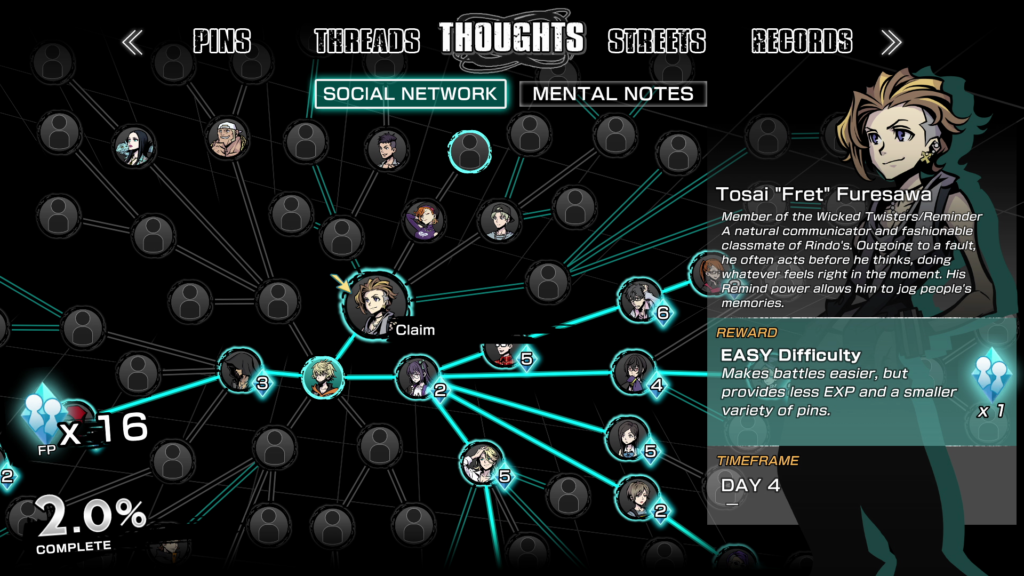
There are many other things you’ll be doing outside of combat of course, and not just long, often dialogue-heavy cutscenes either. Your party is in the “UG”, a kind of limbo after death, and can’t directly interact with the people still alive in the “RG”, or living world, but they can read their thoughts and influence their actions by suggesting thoughts via keywords you learn throughout each in-game day. This is usually a key to unlocking each day’s challenge that the team has to overcome, the end result of which is normally a boss fight but there are often puzzles to solve on the way as well. Each of the three core cast has an extra ability as well, namely the ability to travel back in time to redo key moments (this is entirely story-based and not something you even do outside of the core quest line), dive into the minds of people who have been infected with Noise and cure them by battling the beasts, and remind people of certain things they previously forgot by doing a slightly fiddly picture puzzle mini-game. You also have “Social Links” that can give you game modifiers if you befriend certain characters enough. It all adds to the variety and keeps the admittedly long game feeling a bit more varied as you run through. Much like the original game, you can also increase and lower the difficulty on the fly, with some Pins requiring different levels in different areas, with really the amount of HP and rarer drops in higher levels being the only difference meaning it’s no bad thing to drop to Easy if you’re struggling with a boss.
Overall, the combat is quick and satisfying to play but oddly on days when you do nothing but fighting, it starts to get a bit too repetitive. I guess it’s good in short bursts, which most days is all you’ll do, given the amount of story cutscenes and the like.
Graphics and Sound:
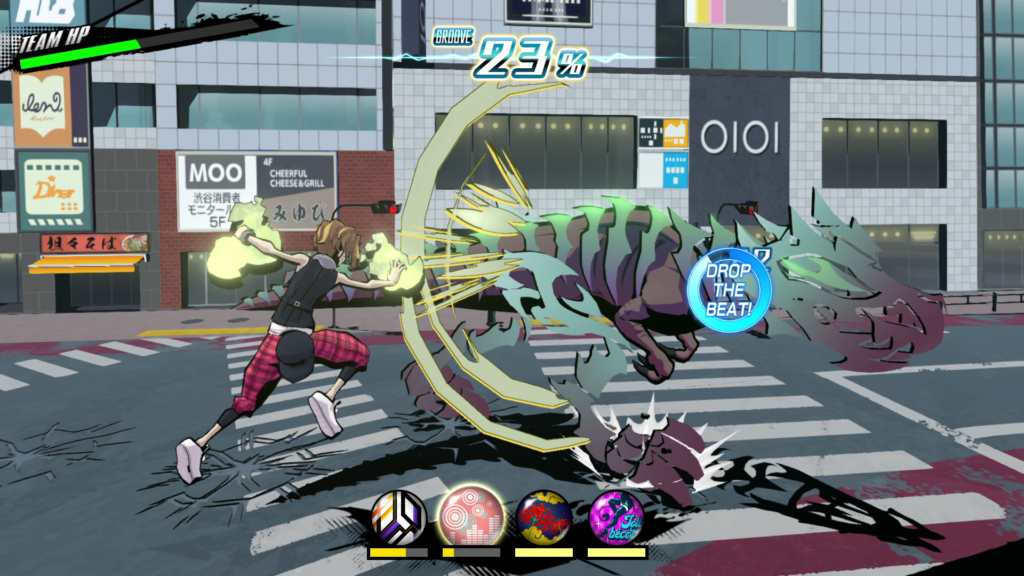
The in-game graphics give a stylized anime look to the main character models and enemies while retaining a more realistic aesthetic to the city of Shibuya itself. They’re not super high rez or anything and sometimes the clash can be a bit distracting, but it’s not a big deal once you get into it. The drawn artwork, used during the many cutscenes, os really good: detailed and well-drawn, with plenty of different expressions that make up for the lack of animation. Everything has a very modern feel, including plenty of smartphone use and graffiti tags, that sort of thing, but I will say that the Persona series did a better job balancing modern ideals without going to quite as much of an obnoxious length as NEO does. There are a couple of actual full anime cutscenes which are of decent quality for a quick few minutes once or twice…
The soundtrack is full of full vocal tracks ranging from hard rock to hip hop to more pop-like songs, plus a few remixes of the original game’s OST. Takeharu Ishimoto, the game’s composer, actually left Square Enix a while ago but returned to score the second game – which paid off, because it’s often catchy and always suits the mood of wandering around a modern city as a group of teens… I mean, I assume anyway, I’m neither a group of people nor a teen (nor in Japan) but the soundtrack worked for me, anyway!
The English voice cast is good in that they captured the characters right (meaning Fret is correctly obnoxious in his “dude-isms”) while the Japanese cast is also right on the money. The English translation does its best attempt to match the characters’ personalities and quirks with modern English slang and syntax, otherwise a straight translation would come across as rather flat without the context of the original Japanese voice actor’s phrasing. It’s one of those hard-to-judge calls that Japanese-to-English translators deal with, but I feel it suits the mood here.
Story:
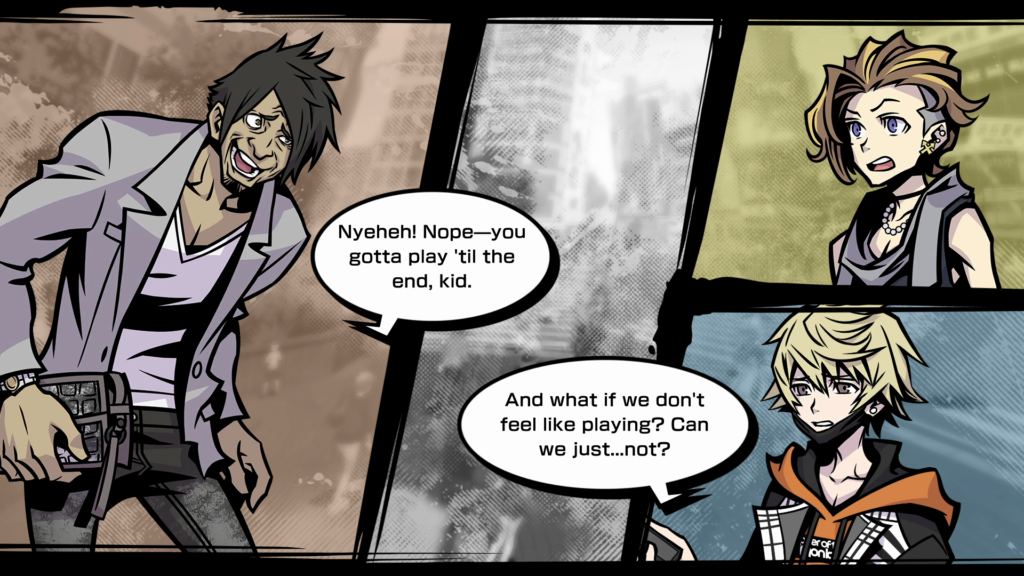
Rindo Kanade and Tosai “Fret” Furesawa are two close friends who suddenly find themselves playing the “Reaper’s Game”, a competition between those who have recently died with the prize being anything the winning team wishes (including returning to life) whereas the forfeit for coming in last place is erasure from existence. Landing in the middle just means playing another session, each session being exactly one week. Rindo and Fret soon meet Sho Minamimoto, a former reaper and antagonist from the original game, and college girl Nagi Usui, who ticks every nerdy otaku cliché on the list.
Dubbed “The Wicked Twisters”, they have to try to win the game to return to life, or at the very least, fight to not come last. That’s the basic premise, as the story goes on, the connection to the original game gets deeper and deeper, which may confuse those who never played the original TWEWY, and while a lot of it is explained via dialogue, some may struggle.
Overall Thoughts:

NEO: The World Ends with You is a fun action JRPG that mixes modern culture with slaying monsters, while adding plenty of story content and, of course, no end of collectables. Once you finish the main storyline you can replay any day and do side quests or generally grind for drops to your hearts content, adding even more re-playability on top of the lengthy core campaign. Recommended for fans of the genre, but those who aren’t may find the core gameplay quite repetitive and the story a little muddled (doubly so if they’ve never played or watched the original TWEWY)


